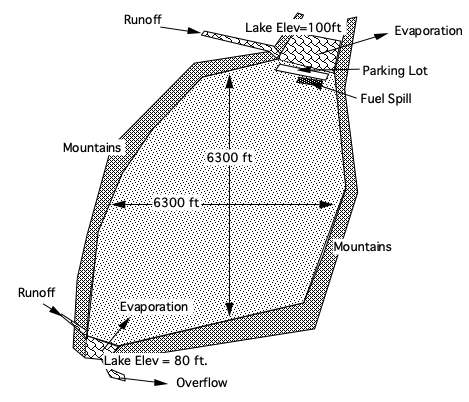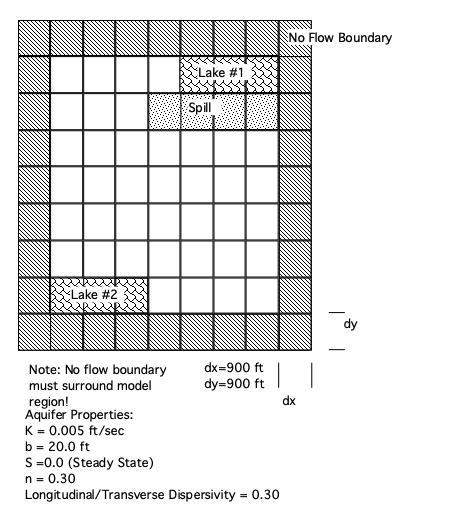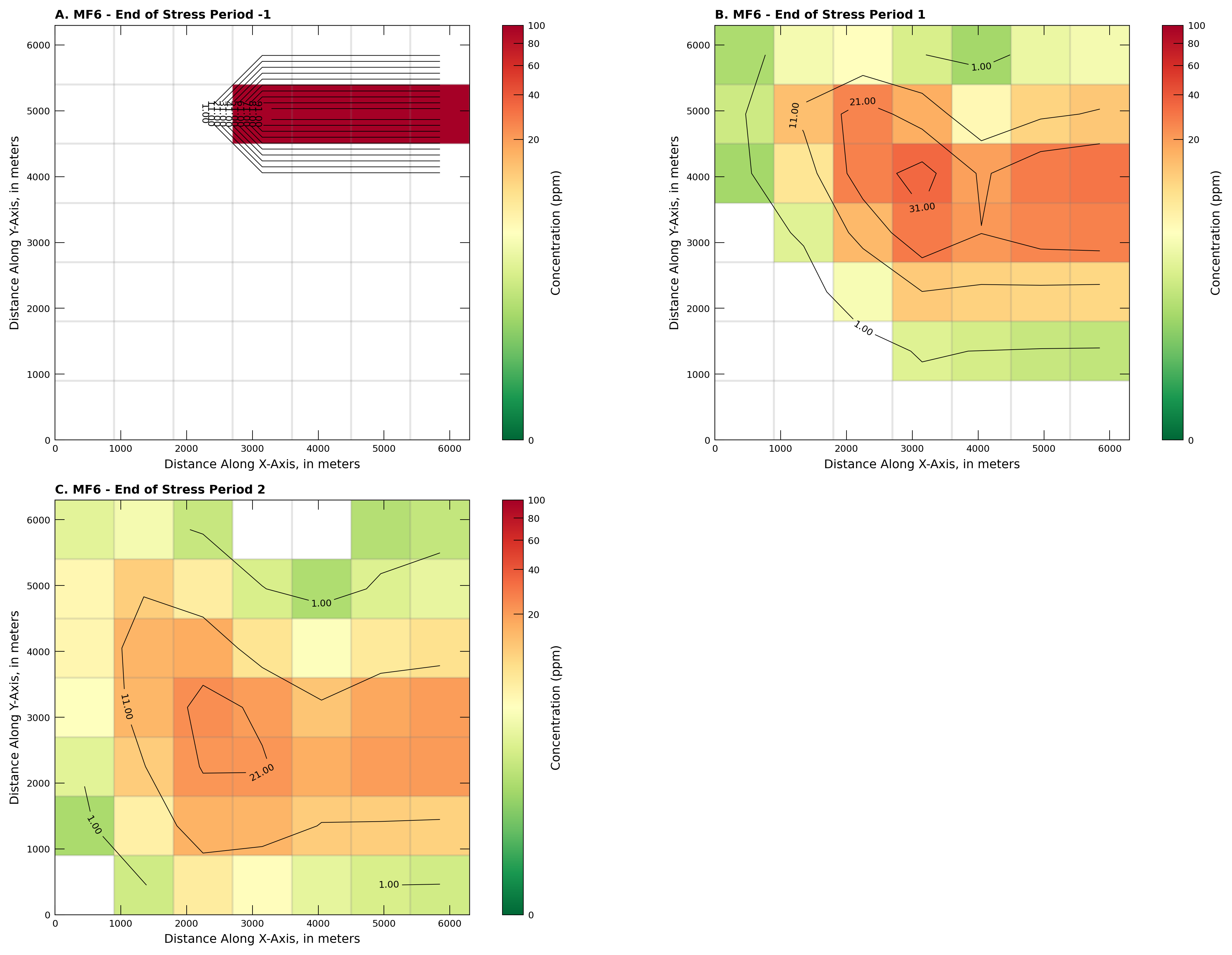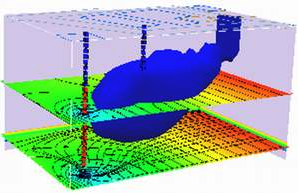Transport Model using MT3DMS and USGS MOC (circa 1980s Example)#
This section recreates an example used in the orginal MOC model and described in some detail at http://54.243.252.9/ce-5364-webroot/ce5364jupyterbook/_build/html/chapters/12.02usgsmocmodel/usgsmoc.html
Example 1:#
Alluvial valley with lakes as shown. Mountains are hydrogeologic barriers. Region is arid.
Problem: Fuel spill at parking area near lake introduces contamination at 100 mg/l over area shown; How will plume spread over time?

Conceptual model:#
Assume 2D confined flow approximation is valid (small drawdowns compared to saturated thickness)
No pumping
Recharge = Evaporation (so net rainfall to aquifer is negligible)
Mountains are no-flow boundaries.
Translate into a computational grid:

Using the sketch above we can construct a MODFLOW6 Flow and Transport model to study the question.
Note
Literally we will simply modify the working model already created to fit the situation. If you end up doing these (models) a lot, much can be automated, but only a handful of people actually become modelers full time and once they get good they get promoted to supervisory roles so their skills can atrophy.
%reset -f
import warnings
warnings.filterwarnings('ignore',category=DeprecationWarning)
Note
The script generates a lot of output that are suppressed by a ; Comment the character out to re-enable full output (which is damn helpful for debugging the script!)
Initial setup#
Import dependencies, define the example name and workspace, and read settings from environment variables.
import os
import pathlib as pl
from pprint import pformat
import flopy
import git
import matplotlib.pyplot as plt
from matplotlib.colors import ListedColormap
import numpy as np
from flopy.plot.styles import styles
from modflow_devtools.misc import get_env, timed
import warnings
warnings.filterwarnings('ignore',category=DeprecationWarning)
Note
The code block above loads various modules into the environment; they must exist and be loaded into the kernel - if not you get a warning “Module Not Found” and will have to install into the kernel (i.e. pip -m install module, or the conda equivalent
Filter warnings repeated to achieve “for sure …” that the filter is applied. By design the filter will not stop ERRORS, and warnings issued within functions will still display, but it will address one annoying deprecation error.
Define parameters#
Define model units, parameters and other settings.
# Model units
length_units = "feet"
time_units = "seconds"
# Model parameters
nlay = 1 # Number of layers
nrow = 7 # Number of rows
ncol = 7 # Number of columns
delr = 900.0 # Column width ($ft$)
delc = 900.0 # Row width ($ft$)
delz = 20.0 # Layer thickness ($ft$)
top = 0.0 # Top of the model ($ft$)
prsity = 0.3 # Porosity
k1 = 0.005 # Horiz. hyd. conductivity of medium grain material ($m/sec$)
inj = 0.001 # Injection well rate ($ft^3/sec$) - no wells this model
ext = -0.001 # Extraction well pumping rate ($ft^3/sec$) - no wells this model
al = 90.0 # Longitudinal dispersivity ($ft$)
trpt = 0.3 # Ratio of horiz. transverse to longitudinal dispersivity
perlen = 2.0 # Simulation time ($years$)
## Values above are same as conceptual model in figure
# Additional model input
hk = k1 * np.ones((nlay, nrow, ncol), dtype=float)
#hk[:, 5:8, 1:8] = k2 only one layer type this case
laytyp = icelltype = 0
# Active model domain
ibound = np.ones((nlay, nrow, ncol), dtype=int)
ibound[0, 0, 4:7] = -1
ibound[0, -1, 0:3] = -1
idomain = np.ones((nlay, nrow, ncol), dtype=int)
icbund = 1
# Boundary conditions
# MF2K5 pumping info
qwell1 = 0.001
qwell2 = -0.0189
welspd = {0: [[0, 3, 6, qwell1], [0, 10, 6, qwell2]]} # Well pumping info for MF2K5
cwell1 = 0.0
cwell0 = 0.0
spd = {
0: [[0, 3, 6, cwell1, 2], [0, 10, 6, cwell0, 2]],
1: [[0, 3, 6, cwell0, 2], [0, 10, 6, cwell0, 2]],
} # Well info 4 MT3D
# MF6 pumping information
wellist_sp1 = []
# (k, i, j), flow, conc
wellist_sp1.append([(0, 3, 6), qwell1, cwell1]) # Injection well
wellist_sp1.append([(0, 10, 6), qwell2, cwell0]) # Pumping well
#
wellist_sp2 = []
# (k, i, j), flow, conc
wellist_sp2.append([(0, 3, 6), qwell1, cwell0]) # Injection well
wellist_sp2.append([(0, 10, 6), qwell2, cwell0]) # Pumping well
spd_mf6 = {0: wellist_sp1, 1: wellist_sp2}
# Transport related
sconc = 0.0
ath1 = al * trpt
dmcoef = 90.0 # m^2/s
# Time variables
perlen = [365.0 * 86400, 365.0 * 86400]
steady = [False, False]
nper = len(perlen)
nstp = [365, 365]
tsmult = [1.0, 1.0]
#
sconc = 0.0
c0 = 0.0
botm = [top - delz]
mixelm = -1
# Solver settings
nouter, ninner = 100, 300
hclose, rclose, relax = 1e-6, 1e-6, 1.0
percel = 1.0 # HMOC parameters
itrack = 2
wd = 0.5
dceps = 1.0e-5
nplane = 0
npl = 0
nph = 16
npmin = 2
npmax = 32
dchmoc = 1.0e-3
nlsink = nplane
npsink = nph
nadvfd = 1
The code block above loads variables and constants to define the actual model. We will focus on how to conceptualize later on.
Assumption
I have assumed that the code surrounds the entire model domain with no-flow cells; it’s what I would do in a general purpose program. I don’t know and the MODFLOW6 report is kind of vague on the underlying technical approach; so I choose to make a guess and see how far I get - this is typical when learning how to operate a program, your mileage may vary
Update
The model indeed surrounds the computation domain with the equivalent of no-flow conditions as per

Descriped on pg. 41 of Documentation for the MODFLOW 6 Groundwater Flow Model, Ch 55, Book A6
ibound
array([[[ 1, 1, 1, 1, -1, -1, -1],
[ 1, 1, 1, 1, 1, 1, 1],
[ 1, 1, 1, 1, 1, 1, 1],
[ 1, 1, 1, 1, 1, 1, 1],
[ 1, 1, 1, 1, 1, 1, 1],
[ 1, 1, 1, 1, 1, 1, 1],
[-1, -1, -1, 1, 1, 1, 1]]])
Model setup#
Define functions to build models, write input files, and run the simulation.
Groundwater Flow Package Build
# Workspace and Executibles
#binary = "/home/sensei/ce-4363-webroot/ModflowExperimental/mf6-arm/mf6" # location on MY computer of the compiled modflow program
#workarea = "/home/sensei/ce-4363-webroot/ModflowExperimental/mf6-arm/mf6_moc1" # location on MY computer to store files this example (directory must already exist)
#workarea = workspace # location on MY computer to store files this example (directory must already exist)
binary = "/home/sensei/mfplayground/modflow-python/mf6.4.1_linux/bin/mf6" # location on AWS computer of the compiled modflow program
workarea = "/home/sensei/ce-5364-webroot/mfexperiments/mf6-ex2" # location on MY computer to store files this example (directory must already exist)
# Set Simulation Name(s)
name = "mf6_moc1"
gwfname = "gwf-" + name
gwtname = "gwt-" + name
##### FLOPY Build simulation framework ####
sim = flopy.mf6.MFSimulation(
sim_name="sim-" + name, exe_name=binary, version="mf6", sim_ws=workarea
)
####### CREATED "/home/sensei/ce-4363-webroot/ModflowExperimental/mf6-arm/mt3d_example9"
The code block above sets paths to the binary (in my case a compiled MODFLOW6 object located at /home/sensei/ce-4363-webroot/ModflowExperimental/mf6-arm/. The binary was built using the make utility operating on the makefile contained in ~path_to_source/mf6.4.1_linux/make
####### Instantiating MODFLOW 6 time discretization ########
tdis_rc = []
for i in range(nper):
tdis_rc.append((perlen[i], nstp[i], tsmult[i]))
flopy.mf6.ModflowTdis(sim, nper=nper, perioddata=tdis_rc, time_units=time_units);
## delete ";" in above line at end to show full output
The code block above sets the time stepping structure. Units are supplied in the model constants already created. perlen is a list of period length in time units of a stress period. , nstp is a list of the number of time steps per period, tsmult is a list of time step multipliers.
####### Instantiating MODFLOW 6 groundwater flow model ########
# Set Model Name (using same base name as the simulation)
model_nam_file = "{}.nam".format(gwfname)
# create MODFLOW6 flow model framework
gwf = flopy.mf6.ModflowGwf(sim, modelname=gwfname, save_flows=True, model_nam_file=model_nam_file)
## delete ";" in above line at end to show full output
The code block above sets prefix of the flow model file names.
###### Instantiating MODFLOW 6 solver for flow model #######
# Set Iterative Model Solution (choose solver parameters)
# about IMS see: https://water.usgs.gov/nrp/gwsoftware/ModelMuse/Help/sms_sparse_matrix_solution_pac.htm
# using defaults see: https://flopy.readthedocs.io/en/3.3.2/source/flopy.mf6.modflow.mfims.html
imsgwf = flopy.mf6.ModflowIms(
sim,
print_option="SUMMARY",
outer_dvclose=hclose,
outer_maximum=nouter,
under_relaxation="NONE",
inner_maximum=ninner,
inner_dvclose=hclose,
rcloserecord=rclose,
linear_acceleration="CG",
scaling_method="NONE",
reordering_method="NONE",
relaxation_factor=relax,
filename=f"{gwfname}.ims",
)
sim.register_ims_package(imsgwf, [gwf.name]);
## delete ";" in above line at end to show full output
The code block above sets the iteration and solver parameters. URL to documents is included in the comments.
###### Instantiating MODFLOW 6 discretization package ######
flopy.mf6.ModflowGwfdis(
gwf,
length_units=length_units,
nlay=nlay,
nrow=nrow,
ncol=ncol,
delr=delr,
delc=delc,
top=top,
botm=botm,
idomain=idomain,
filename=f"{gwfname}.dis",
);
## delete ";" in above line at end to show full output
The code block above sets the spatial structure. We must supply layers, rows, columns, and spacing between rows and columns (i.e. how big is a pixel). Vertical spacing computed as
###### Instantiating MODFLOW 6 initial conditions package for flow model #######
strt = np.zeros((nlay, nrow, ncol), dtype=float)
strt[0, 0, 4:7] = 100.0 # set top row t0 100
xc = gwf.modelgrid.xcellcenters
strt[0, -1, 0:3] = 80.0 # set bottom row to 80
flopy.mf6.ModflowGwfic(gwf, strt=strt, filename=f"{gwfname}.ic")
## delete ";" in above line at end to show full output
package_name = ic
filename = gwf-mf6_moc1.ic
package_type = ic
model_or_simulation_package = model
model_name = gwf-mf6_moc1
Block griddata
--------------------
strt
{internal}
(array([[[ 0., 0., 0., 0., 100., 100., 100.],
[ 0., 0., 0., 0., 0., 0., 0.],
[ 0., 0., 0., 0., 0., 0., 0.],
[ 0., 0., 0., 0., 0., 0., 0.],
[ 0., 0., 0., 0., 0., 0., 0.],
[ 0., 0., 0., 0., 0., 0., 0.],
[ 80., 80., 80., 0., 0., 0., 0.]]]))
The code block above sets the initial conditions. The top row in this example is set to 100, the bottom row to 80.0. If there are other starting conditions either write code or read from a file, or hard-code the constants as needed.
# Instantiating MODFLOW 6 node-property flow package
flopy.mf6.ModflowGwfnpf(
gwf,
save_flows=False,
icelltype=icelltype,
k=hk,
k33=hk,
save_specific_discharge=True,
filename=f"{gwfname}.npf",
);
## delete ";" in above line at end to show full output
The code block above sets the node-property data (its like the old BCF package). Here we supply that we want to save sp. discharge (needed for transport), the k, and k33 values the same implies NOT unconfined sustem.
# Instantiate storage package
sto = flopy.mf6.ModflowGwfsto(gwf, ss=1.0e-05);
## delete ";" in above line at end to show full output
The code block above sets the storage properties for transient simulations.
# Instantiating MODFLOW 6 constant head package
# MF6 constant head boundaries:
chdspd = []
# Loop through the top & bottom sides.
for j in range(4,7):
# l, r, c, head, conc
chdspd.append([(0, 0, j), 100.0, 0.0]) # Top boundary
for j in range(0,3):
chdspd.append([(0, 6, j), 80.0, 0.0]) # Bottom boundary
chdspd = {0: chdspd}
flopy.mf6.ModflowGwfchd(
gwf,
maxbound=len(chdspd),
stress_period_data=chdspd,
save_flows=False,
auxiliary="CONCENTRATION",
pname="CHD-1",
filename=f"{gwfname}.chd",
);
## delete ";" in above line at end to show full output
The code block above sets the constant head boundary conditions.
Note
I have intentionally supressed the well package for this example; it should still work because its MODULAR!
# Instantiating MODFLOW 6 output control package for flow model
flopy.mf6.ModflowGwfoc(
gwf,
head_filerecord=f"{gwfname}.hds",
budget_filerecord=f"{gwfname}.bud",
headprintrecord=[("COLUMNS", 10, "WIDTH", 15, "DIGITS", 6, "GENERAL")],
saverecord=[("HEAD", "LAST"), ("BUDGET", "LAST")],
printrecord=[("HEAD", "LAST"), ("BUDGET", "LAST")],
);
## delete ";" in above line at end to show full output
The code block above defines parts of output control.
Transport Package Building
###### Instantiating MODFLOW 6 groundwater transport package ##########
gwtname = "gwt-" + name
gwt = flopy.mf6.MFModel(
sim,
model_type="gwt6",
modelname=gwtname,
model_nam_file=f"{gwtname}.nam",
)#;
## delete ";" in above line at end to show full output
gwt.name_file.save_flows = True
The code block above sets prefix of the transport model file names.
# create iterative model solution and register the gwt model with it
imsgwt = flopy.mf6.ModflowIms(
sim,
print_option="SUMMARY",
outer_dvclose=hclose,
outer_maximum=nouter,
under_relaxation="NONE",
inner_maximum=ninner,
inner_dvclose=hclose,
rcloserecord=rclose,
linear_acceleration="BICGSTAB",
scaling_method="NONE",
reordering_method="NONE",
relaxation_factor=relax,
filename=f"{gwtname}.ims",
)
sim.register_ims_package(imsgwt, [gwt.name])#;
## delete ";" in above line at end to show full output
The code block above sets the iteration and solver parameters.
###### Instantiating MODFLOW 6 transport discretization package #####
flopy.mf6.ModflowGwtdis(
gwt,
nlay=nlay,
nrow=nrow,
ncol=ncol,
delr=delr,
delc=delc,
top=top,
botm=botm,
idomain=idomain,
filename=f"{gwtname}.dis",
);
## delete ";" in above line at end to show full output
The code block above sets the spatial structure. We must supply layers, rows, columns, and spacing between rows and columns (i.e. how big is a pixel). Vertical spacing computed as
Typically will be same as flow model.
# Instantiating MODFLOW 6 transport initial concentrations
sconc = np.zeros((nlay, nrow, ncol), dtype=float)
sconc[0, 1, 3:7] = 100.0 # set fuel spill row
flopy.mf6.ModflowGwtic(gwt, strt=sconc, filename=f"{gwtname}.ic")
## delete ";" in above line at end to show full output
package_name = ic
filename = gwt-mf6_moc1.ic
package_type = ic
model_or_simulation_package = model
model_name = gwt-mf6_moc1
Block griddata
--------------------
strt
{internal}
(array([[[ 0., 0., 0., 0., 0., 0., 0.],
[ 0., 0., 0., 100., 100., 100., 100.],
[ 0., 0., 0., 0., 0., 0., 0.],
[ 0., 0., 0., 0., 0., 0., 0.],
[ 0., 0., 0., 0., 0., 0., 0.],
[ 0., 0., 0., 0., 0., 0., 0.],
[ 0., 0., 0., 0., 0., 0., 0.]]]))
Initial conditions (concentration) for transport.
# Instantiating MODFLOW 6 transport advection package
if mixelm >= 0:
scheme = "UPSTREAM"
elif mixelm == -1:
scheme = "TVD"
else:
raise Exception()
flopy.mf6.ModflowGwtadv(gwt, scheme=scheme, filename=f"{gwtname}.adv");
## delete ";" in above line at end to show full output
Advective transport methods. In this example upwind formulation with Total Variation Diminishing (TVD) flux limiters. A TVD formulation is a numerical method designed to ensure that the computed solution to a transport equation does not exhibit non-physical oscillations or spurious oscillations, particularly near discontinuities or steep gradients. This flux limitation is crucial for maintaining the accuracy and stability of the numerical solution in simulations involving advective transport, such as contaminant transport in groundwater models.
Key points about TVD formulations:
Purpose: TVD methods aim to prevent the introduction of oscillations or artifacts in the numerical solution that can arise from the discretization of the transport equation, especially in regions with sharp gradients or discontinuities.
Techniques: TVD schemes use various strategies to achieve this, including modifying the standard discretization approaches, using flux limiters, or applying specific numerical flux functions that ensure the total variation of the solution is not increased.
Applications: TVD methods are commonly used in computational fluid dynamics, meteorology, and environmental modeling where accurate representation of transport processes is essential. In groundwater modeling, TVD formulations help to ensure realistic simulation of contaminant transport and avoid numerical artifacts that could lead to incorrect predictions.
Examples: Common TVD schemes include the TVD Runge-Kutta methods, TVD Lax-Wendroff schemes, and various other high-resolution schemes that incorporate flux limiters or other modifications to ensure total variation diminishing properties.
# Instantiating MODFLOW 6 transport dispersion package
if al != 0:
flopy.mf6.ModflowGwtdsp(
gwt,
alh=al, # longitudinal
ath1=ath1, # transverse
filename=f"{gwtname}.dsp",
);
## delete ";" in above line at end to show full output
This code iniatiates the dispersion method with Longitudinal dispersivity \(a_l = 20.0~m\) and the ratio of horizontal transverse to longitudinal dispersivity \(trpt = 0.2\) In the above script \(a_t = trpt \times a_l\)
# Instantiating MODFLOW 6 transport mass storage package
flopy.mf6.ModflowGwtmst(
gwt,
porosity=prsity,
first_order_decay=False,
decay=None,
decay_sorbed=None,
sorption=None,
bulk_density=None,
distcoef=None,
filename=f"{gwtname}.mst",
);
## delete ";" in above line at end to show full output
Code block sets adsorbtion/desorbtion and 1st order decay terms if any.
# Instantiating MODFLOW 6 transport source-sink mixing package
#sourcerecarray = [
# ("WEL-1", "AUX", "CONCENTRATION"),
# ("CHD-1", "AUX", "CONCENTRATION"),
# ]
sourcerecarray = [
("CHD-1", "AUX", "CONCENTRATION"),
]
flopy.mf6.ModflowGwtssm(
gwt,
sources=sourcerecarray,
print_flows=True,
filename=f"{gwtname}.ssm",
);
## delete ";" in above line at end to show full output
Code above manages source/sink mixing terms.
# Instantiating MODFLOW 6 transport output control package
flopy.mf6.ModflowGwtoc(
gwt,
budget_filerecord=f"{gwtname}.cbc",
concentration_filerecord=f"{gwtname}.ucn",
concentrationprintrecord=[("COLUMNS", 10, "WIDTH", 15, "DIGITS", 6, "GENERAL")],
saverecord=[("CONCENTRATION", "LAST"), ("BUDGET", "LAST")],
printrecord=[("CONCENTRATION", "LAST"), ("BUDGET", "LAST")],
filename=f"{gwtname}.oc",
);
## delete ";" in above line at end to show full output
Output control for transport
# Instantiating MODFLOW 6 flow-transport exchange mechanism
flopy.mf6.ModflowGwfgwt(
sim,
exgtype="GWF6-GWT6",
exgmnamea=gwfname,
exgmnameb=gwtname,
filename=f"{name}.gwfgwt",
);
## delete ";" in above line at end to show full output
Code above manages how flow (gwf) and transport (gwt) exchange information at each time step.
Generate the Files
sim.write_simulation(silent=True)
Running the Model
#success, buff = sim.run_simulation(silent=False, report=True)#Verbose output
success, buff = sim.run_simulation(silent=True, report=True)#Suppress output
assert success, pformat(buff)
Plotting results#
Plotting model results.
Note
Even more reverse engineering to produce plots; took a fair bit of reading on the mighty internet to hack these plots. We will compare to the elderly USGS-MOC code for the same problem.
import copy
import matplotlib as mpl
import matplotlib.colors as mcolors
# Figure properties
figure_size = (14, 10)
# Get the MF6 concentration output
gwt = sim.get_model(list(sim.model_names)[1])
ucnobj_mf6 = gwt.output.concentration()
conc_mf6 = ucnobj_mf6.get_alldata()
# Create figure for scenario
with styles.USGSPlot() as fs:
sim_name = sim.name
plt.rcParams["lines.dashed_pattern"] = [5.0, 5.0]
levels = np.arange(1.0, 100., 10.0)
# end stress period -1 (initial conditions)
################################ Initial Conditions (notice the cflood object uses sconc array)#################
axWasNone = False
fig = plt.figure(figsize=figure_size, dpi=300, tight_layout=True)
axWasNone = True
ax = fig.add_subplot(2, 2, 1, aspect="equal") ### 2X2 Plot matrix, this is upper left
cflood = np.ma.masked_less_equal(sconc, 0.2)
mm = flopy.plot.PlotMapView(ax=ax, model=gwf)
cmap = copy.copy(mpl.cm.get_cmap("RdYlGn_r"))
cmap.set_bad(color='none')
colors = ['saddlebrown', 'goldenrod']
cmap = ListedColormap(colors)
mm.plot_ibound()
mm.plot_grid(color=".5", alpha=0.2)
cmap = copy.copy(mpl.cm.get_cmap("RdYlGn_r"))
cmap.set_bad(color='none')
# Adjust normalization to skew values towards green
norm = mcolors.PowerNorm(gamma=0.2, vmin=0, vmax=100) # Lower gamma pushes towards green
# Plot using the adjusted normalization
cs = mm.plot_array(cflood[0], alpha=1.0, norm=norm, cmap=cmap)
# Add a colorbar to the plot
cbar = plt.colorbar(cs, orientation='vertical')
cbar.set_label('Concentration (ppm)') # Replace with appropriate label for your data
cs = mm.contour_array(sconc, colors="k", levels=levels, linewidths=0.5)
plt.clabel(cs, fmt='%.2f')
plt.xlabel("Distance Along X-Axis, in meters")
plt.ylabel("Distance Along Y-Axis, in meters")
title = "MF6 - End of Stress Period " + str(-1)
# set idx
idx = 0
letter = chr(ord("@") + idx + 1)
styles.heading(letter=letter, heading=title)
################################## Results From Simulation ##########################
# end stress period 0
stp_idx = 0 # 0-based (out of 2 possible stress periods)
axWasNone = True
ax = fig.add_subplot(2, 2, 2, aspect="equal") ### 2X2 Plot matrix, this is upper right
cflood = np.ma.masked_less_equal(conc_mf6[stp_idx], 0.2)
mm = flopy.plot.PlotMapView(ax=ax, model=gwf)
cmap = copy.copy(mpl.cm.get_cmap("RdYlGn_r"))
#cmap = plt.get_cmap('RdYlGn_r')
cmap.set_bad(color='none')
colors = ['saddlebrown', 'goldenrod']
cmap = ListedColormap(colors)
mm.plot_ibound()
mm.plot_grid(color=".5", alpha=0.2)
cmap = copy.copy(mpl.cm.get_cmap("RdYlGn_r"))
cmap.set_bad(color='none')
# Adjust normalization to skew values towards green
norm = mcolors.PowerNorm(gamma=0.2, vmin=0, vmax=100) # Lower gamma pushes towards green
# Plot using the adjusted normalization
cs = mm.plot_array(cflood[0], alpha=1.0, norm=norm, cmap=cmap)
# Add a colorbar to the plot
cbar = plt.colorbar(cs, orientation='vertical')
cbar.set_label('Concentration (ppm)') # Replace with appropriate label for your data
cs = mm.contour_array(conc_mf6[stp_idx], colors="k", levels=levels, linewidths=0.5)
plt.clabel(cs, fmt='%.2f')
plt.xlabel("Distance Along X-Axis, in meters")
plt.ylabel("Distance Along Y-Axis, in meters")
title = "MF6 - End of Stress Period " + str(stp_idx + 1)
# set idx
idx = 1
letter = chr(ord("@") + idx + 1)
styles.heading(letter=letter, heading=title)
# end stress period 1
stp_idx = 1 # 0-based (out of 2 possible stress periods)
if axWasNone:
ax = fig.add_subplot(2, 2, 3, aspect="equal",label = "subplot2") ### 2X2 Plot matrix, this is lower left
cflood = np.ma.masked_less_equal(conc_mf6[stp_idx], 0.2)
mm = flopy.plot.PlotMapView(ax=ax, model=gwf)
colors = ['saddlebrown', 'goldenrod']
cmap = ListedColormap(colors)
mm.plot_ibound()
mm.plot_grid(color=".5", alpha=0.2)
cmap = copy.copy(mpl.cm.get_cmap("RdYlGn_r"))
cmap.set_bad(color='none')
# Adjust normalization to skew values towards green
norm = mcolors.PowerNorm(gamma=0.2, vmin=0, vmax=100) # Lower gamma pushes towards green
# Plot using the adjusted normalization
cs = mm.plot_array(cflood[0], alpha=1.0, norm=norm, cmap=cmap)
# Add a colorbar to the plot
cbar = plt.colorbar(cs, orientation='vertical')
cbar.set_label('Concentration (ppm)') # Replace with appropriate label for your data
cs = mm.contour_array(conc_mf6[stp_idx], colors="k", levels=levels, linewidths=0.5)
plt.clabel(cs, fmt='%.2f')
plt.xlabel("Distance Along X-Axis, in meters")
plt.ylabel("Distance Along Y-Axis, in meters")
title = "MF6 - End of Stress Period " + str(stp_idx + 1)
# set idx
idx = 2
letter = chr(ord("@") + idx + 1)
styles.heading(letter=letter, heading=title)
### 2X2 Plot matrix, lower right is null

The plume “color map” is overlain on the computational grid, and is set to opaque (not transparent). The color ramp is and inverted GreenYellowRed. The scale bar is distorted to emphasize concentrations bigger than 10.0 ppm in the plot call. High values render as red, lowest as green, the white cells are strict zero (there is no constituient mass in those cells yet.
Conclusions#
Reverse engineered enough to be able to model reasonably complex situations. The reader should experiment how to get specific discharge out of the model and plot as a “arrow plot” to show flow directions.
